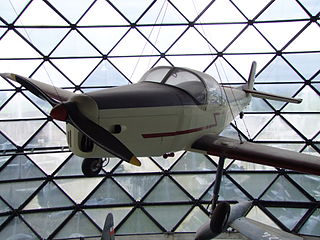
The Zlin Z-26 Trener was a tandem-seat basic training aircraft built by the Czechoslovakian company Moravan. A low-wing monoplane of largely wooden construction, it was developed into a series of all-metal trainers. Several were also produced in aerobatic variants, known as the Akrobat.

PZL M-4 Tarpan was a Polish trainer and sports aircraft prototype of the 1960s, designed in WSK-Mielec.

The Nord Aviation 3202 is a 1950s French military trainer aircraft designed and built by Nord Aviation to meet a French Army requirement for a two-seat basic trainer, as a replacement for the biplane Stampe SV.4. Altogether, 101 examples were built, with the first flying on 17 April 1957.

The Bölkow Bo 207 was a four-seat light aircraft built in West Germany in the early 1960s, a development of the Klemm Kl 107 built during World War II.

The LIBIS KB-6 Matajur was a 1950s Slovenian two-seat light monoplane designed and produced by LIBIS aircraft during Yugoslavian period.

The DINFIA IA 45 Querandi was a 1950s Argentine twin-engined light transport aircraft built by the DINFIA.

The PZL-102 Kos (blackbird) is a Polish two-seat touring and training monoplane designed and built by PZL.
The Partenavia P.59 Jolly was an Italian two-seat training monoplane designed by Partenavia to meet a requirement for the Aero Club d'Italia. First fight was in 1960.

The Nord 3400 Norbarbe was a French two-seat observation and casualty-evacuation aircraft built by Nord Aviation for the French Army Light Aviation.

The Scintex ML 250 Rubis was a French civil utility aircraft of the 1960s.

The Slingsby T.49 Capstan is a British two-seat glider of the 1960s built by Slingsby Sailplanes as a replacement for their earlier Type 42 Eagle.

The Beecraft Queen Bee was an American V-tailed four-seat cabin monoplane, designed and built by Bee Aviation Associates (Beecraft).
The Civil Aviation Department RG-1 Rohini is an Indian two-seat training sailplane of the 1960s. A high-winged wooden monoplane, with side-by-side seating;at least 107 were built.
The LIBIS-17 was a two-seat sailplane for advanced glider training. It was built in Yugoslavia (Slovenia) in the early 1960s and achieved production.
The Procaer Cobra was a two-seat turbojet powered light aircraft designed and built in Italy and flown in the early 1960s. Only one was completed.

The Turbay T-3A was an Argentine twin-engined seven-seater light transport of the 1960s. A single example was built, but no production followed.
The IIL IS-4 was a single seat, high performance sailplane designed by Iosif Șilimon and built in Romania in the late 1950s.
The IIL IS-7 was a two-seat, sailplane designed by Iosif Șilimon and built in Romania in the late 1950s. Only one prototype was built.
The IIL IS-8 was a two-seat sailplane designed by Iosif Șilimon and built in Romania in 1960. They served with Romanian gliding clubs.
The LIBIS 180 is a Slovenian sporty three-seater mixed-construction aircraft, mostly wooden with a tail wheel, designed and produced at LIBIS aircraft during Yugoslavian period.












